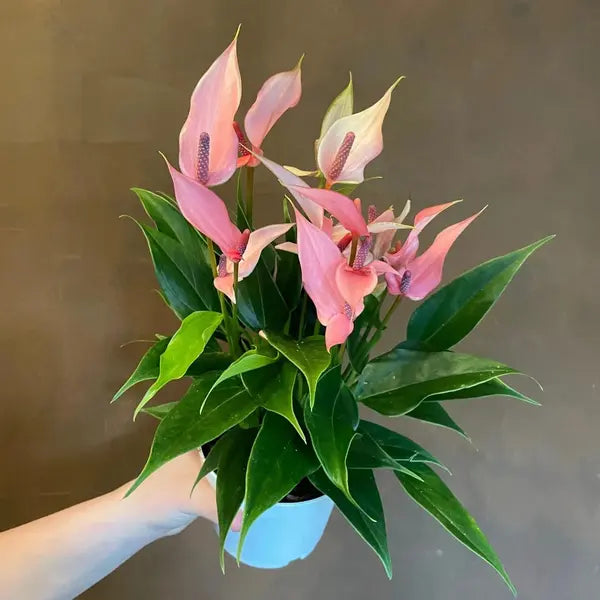
Anthurium Lilli Pink - Double Shoot
Selling Size : Please Choose | Pot Included | Secure Packing
The Anthurium Lilli Pink also known as the 'Flamingo Flower or Laceleaf' , is a beautiful and relatively easy-to-care-for houseplant that can bring vibrant color to your home.
Here's a detailed guide care for anthurium lilli pink:
1. Light:
Bright, indirect light is key. Mimic its natural rainforest habitat where it grows under a canopy of larger trees.
Place it near a bright window, but ensure it's out of direct sunlight, which can scorch its glossy leaves.
Insufficient light can lead to poor growth and fewer blooms, while too much direct sun will burn the leaves.
If you notice it's not blooming as much as you'd like, it might need a bit more light.
2. Watering:
Allow the top 50-75% (or 2-3 inches) of the soil to dry out between waterings.
Water thoroughly until liquid flows through the drainage hole at the bottom of the pot.
Never let your Anthurium sit in standing water, as it's highly susceptible to root rot.
Yellow leaf tips can indicate overwatering, while brown leaf tips might suggest underwatering.
Reduce watering frequency in winter when growth slows down.
Using filtered, bottled, or tap water that has sat for 24 hours to allow chemicals to dissipate is beneficial.
3. Humidity:
Anthuriums are tropical plants and thrive in high humidity environments (ideally 60-80%).
To increase humidity:
Mist the foliage regularly (daily or every few days, especially in dry climates or during winter). Avoid misting the flowers directly.
Place the pot on a pebble tray filled with water (ensure the pot isn't sitting in the water).
Use a humidifier nearby.
Group it with other plants, as this can create a more humid microclimate.
4. Temperature:
Maintain average to warm temperatures, ideally between 18-27°C (65-80°F).
Avoid temperatures below 15°C (60°F), as this can damage the plant.
Keep your Anthurium away from cold drafts, heating and air conditioning vents, or fans, as sudden temperature changes can stress the plant.
5. Soil and Potting:
Anthuriums are often epiphytic in nature, meaning they grow on other plants rather than directly in soil. This means they need a loose, well-draining, and aerated potting mix.
A good mix could be a 50-50 blend of orchid potting media and regular houseplant potting mix, or a mix with ingredients like coco peat, perlite, and charcoal chips.
They prefer slightly acidic to moderately acidic soil (pH 4.5-5.5).
Ensure the pot has drainage holes to prevent waterlogging.
Repot every 2-3 years, or when you see roots growing out of the drainage holes or circling the surface of the soil. They generally prefer to be a bit root-bound.
6. Fertilizer:
Feed your Anthurium monthly during the spring and summer growing season.
Use a liquid houseplant fertilizer diluted to half or quarter strength.
For best blooms, choose a fertilizer with a higher phosphorus number (the middle number in the N-P-K ratio).
Avoid fertilizing in the late fall and winter, as the plant is typically resting.
Leach salt residue buildup by flushing the potted plant each month with clear water.
7. Pruning:
Pruning is minimal. Remove older, yellowing, or browning leaves and spent flowers by snipping them off at the base of the stem with clean, sharp shears. This encourages new growth and blooms.
You can also prune to shape the plant if desired, ensuring you leave at least 3-4 leaves on the plant.
8. Toxicity:
Anthurium 'Lilli Pink' is considered toxic to humans and pets if ingested. Keep it out of reach of children and animals. Its sap can also cause skin and eye irritation.
9. Pests:
Regularly inspect your plant for pests like mealybugs, spider mites, and thrips.
Address any infestations early with appropriate methods, such as insecticidal soap.
By following these care tips, your Anthurium 'Lilli Pink' should thrive and reward you with its beautiful, long-lasting blooms!

